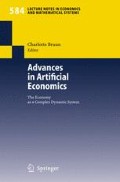Abstract
In this paper, we use an agent based artificial stock market to explore the relations between the heterogeneity of investors behaviour and the aggregated behaviour of financial markets. In particular, we want to recover the main statistical features of the Spanish Stock Market, as the high levels of kurtosis, excess volatility, non normality of prices and returns, unit roots and volatility clustering.
We realise that we cannot catch up most of this features in a market populated only with fundamental investors, so we need to include more heterogeneity in agents behaviour. We include psychological investors who change their risk aversion following the ideas by Kahneman and Tversky (1979) and technical traders who buy or sell depending on crosses of moving averages. The main conclusion is that, in this particular artificial stock market, psychological investors are related to volatility clustering whereas technical trading has more to do with unit roots.
Access this chapter
Tax calculation will be finalised at checkout
Purchases are for personal use only
Preview
Unable to display preview. Download preview PDF.
References
Cont R. (2001) Empirical properties of asset returns: stylised facts and statistical issues. Quantitative Finance, Vol 1, pp 223–236.
Axelrofd (1997) “Advancing the Art of Simulation in the Social Sciences”, Complexity Vol. 3, pp. 193–199.
Epstein, J. M., and Axtell, R. (1996) Growing Artificial Societies: Social Science From the Bottom Up. Cambridge, MA: MIT Press.
Epstein, J.M.; Axtell, R. (1997). “Artificial Societies and Generative Social Science”. Artificial Life and Robotics Vol. 1, pp. 33–34.
Fama, E. F., (1998) “Market efficiency, long-term returns, and behavioral finance”, Journal of Financial Economics, Vol. 49. pp. 283–306.
Kahneman D., and Tversky A (1979) Prospect theory: An analysis of decisions under risk”. Econometrica, 47, pp 313–327.
LeBaron B., Arthur W.B. and Palmer R. (1999) Time series properties of an artificial stock market. Journal of Economic Dynamics and Control, vol 23, pp 1487–1516.
Lux, T. and Marchesi, M. (1999). “Scaling and criticality in a stochastic multi-agent model of a financial market”. Nature, 397:498–500.
Lux, T. and Marchesi, M. (2000). “Volatility Clustering in financial markets: a micro-simulation of interacting agents”. International Journal of Applied Finance, 3, pp: 675–702.
Morone, A. 2005. “Financial Market in the Laboratory, an Experimental Analysis of some Stylized Facts,” Discussion Papers on Strategic Interaction 2005–27, Max Planck Institute of Economics, Strategic Interaction Group
Pajares J., Pascual J.A., Hernández C. and López-Paredes A. (2003) A behavioural, evolutionary and generative approach for modelling financial markets. 1st Conference of the European Social Simulation Association (ESSA). Groningen. The Netherlands.
Pajares J., Pascual J.A., Hernández C. and López-Paredes A. (2005). The role of risk aversion and technical trading in the behaviour of financial markets 3rd Conference of the European Social Simulation Association (ESSA). Koblenz. Germany. Sept 2005.
Pascual J. A. (2006). Modelado Multiagente de Mercados Financieros: Un Enfoque basado en el Comportamiento Individual de los Inversores. Tesis Doctoral. Departamento de Organización de Empresas y C.I.M. ETS de Ingenieros Industriales. Universidad del Valladolid.
Shiller, R. J. (1981) “Do Stock Prices Move Too Much to be Justified by Subsequent Changes in Dividends?” The American Economic Review, Vol. 1, Issue 3, pp. 421–436
Tversky A and Kahneman D (1992), “Advances in Prospect Theory: Cumulative Representation of Uncertainty”. Journal of Risk and Uncertainty, Vol. 5(4) pp. 297–323.
Author information
Authors and Affiliations
Editor information
Editors and Affiliations
Rights and permissions
Copyright information
© 2006 Springer-Verlag Berlin Heidelberg
About this chapter
Cite this chapter
Pascual, J.A., Pajares, J., López-Paredes, A. (2006). Explaining the Statistical Features of the Spanish Stock Market from the Bottom-Up. In: Bruun, C. (eds) Advances in Artificial Economics. Lecture Notes in Economics and Mathematical Systems, vol 584. Springer, Berlin, Heidelberg. https://doi.org/10.1007/3-540-37249-0_20
Download citation
DOI: https://doi.org/10.1007/3-540-37249-0_20
Publisher Name: Springer, Berlin, Heidelberg
Print ISBN: 978-3-540-37247-9
Online ISBN: 978-3-540-37249-3
eBook Packages: Computer ScienceComputer Science (R0)

